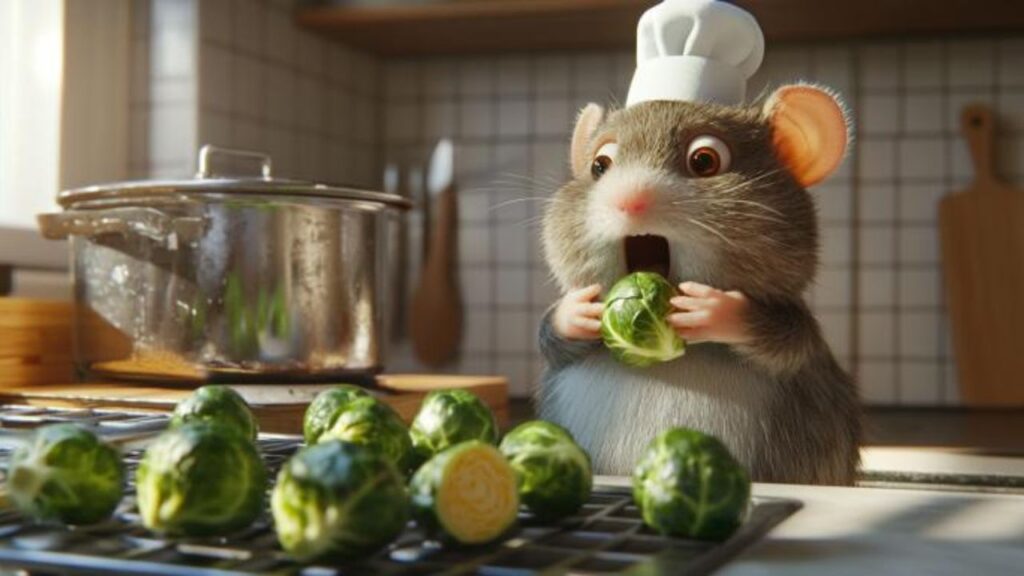Summary – TL;DR
Bell peppers can be a nutritious and colorful addition to your hamster’s diet, rich in essential vitamins like A, C, and E, as well as fiber and antioxidants. They come in various colors, each with its own nutrient profile. Originating from regions with a diverse diet, hamsters have evolved to consume a variety of fruits and vegetables, making bell peppers a suitable option.
However, moderation is crucial. Introduce bell peppers slowly and in small quantities to avoid gastrointestinal discomfort. Always opt for fresh, organic bell peppers and wash them thoroughly to remove any pesticides. Remove seeds and stems to prevent choking hazards, and chop the peppers into small, bite-sized pieces.
Veterinarians generally agree that bell peppers can be a healthy part of a hamster’s diet when introduced carefully. Some caution against too many fresh vegetables due to hamsters’ sensitive digestive systems, while others emphasize the importance of washing to remove potential toxins.
To safely introduce bell peppers, start with a small piece and observe your hamster for any signs of discomfort or allergies. If all goes well, bell peppers can be a regular but moderate part of their diet, offered 2-3 times a week.
In summary, bell peppers can be a beneficial and enjoyable addition to your hamster’s diet when introduced gradually and consumed in moderation.
Introduction
Ah, the magnificent world of hamsters — a place where curiosity meets adorable, and where the smallest of things can bring the greatest of joys. But as any seasoned hamster enthusiast or a budding rodentologist would tell you, navigating the dietary preferences of these fluffy creatures is both an art and a science. Today, we delve deep into the often asked question, “can hamsters eat bell peppers?”
Join me, as we unravel the mysteries of the hamster diet, and explore whether bell peppers can be a vibrant, crunchy addition to your hamster’s mealtime.
A Scientific Overview of Bell Peppers
Nutritional Composition
Bell peppers, also known as sweet peppers, are packed with nutrients beneficial not just for humans but potentially for our furry friends too. They are a rich source of vitamins A, C, and E, and boast a healthy dose of antioxidants. Moreover, they provide fiber, which is essential for a healthy digestive system.
Varying Colors, Varying Nutrients
While we often generalize them as “bell peppers,” these crunchy delights come in a vibrant array of colors including green, yellow, orange, and red. The different hues not only indicate a different taste but also a slight variance in nutritional composition. For instance, red bell peppers contain higher levels of antioxidants compared to their green counterparts.
In the upcoming section, we will delve into how these nutritional compositions align with a hamster’s dietary needs, giving you a scientific pathway to answering the core question: can hamsters eat bell peppers?
The Rodent Palette: Hamsters and Bell Peppers

Historical Background of Hamsters’ Dietary Habits in the Wild
To truly understand the gastronomic preferences of hamsters, we need to take a few steps back and venture into the natural habitats of these adorable rodents. Hamsters are originally from regions spanning Syria and Greece, where their diet predominantly consists of grains, seeds, fruits, vegetables, and even small insects.
In the wild terrains, the vibrant and colorful world of fruits and vegetables is a part of their natural foraging itinerary. They have evolved to have a diet rich in fiber, vitamins, and minerals – a palette developed over thousands of years in natural habitats brimming with fresh produce.
However, it is essential to note that while hamsters have a historic background of indulging in a variety of veggies, their digestive systems are delicate. This brings us to the big question under the spotlight: “Can hamsters eat bell peppers?”, a query that requires us to harmonize historical data with scientific evidence and veterinary insights to arrive at a conclusion that ensures the wellness of our pet hamsters.
How Bell Peppers Can Fit into the Domestic Hamster’s Diet
Transitioning from the historical landscapes to the cozy corners of our homes, it’s important to judiciously craft a diet for our domestic hamster buddies that aligns with their natural dietary patterns while also taking into account their contemporary living environment.
Bell peppers can indeed be a nourishing inclusion in your hamster’s diet, bestowed with a rich nutrient profile that we discussed in the previous section. The high vitamin C content in bell peppers can be particularly beneficial, as hamsters are unable to synthesize this vital nutrient themselves. Therefore, a controlled introduction of bell peppers can be a great way to supplement their vitamin C intake.
Moreover, the fibrous nature of bell peppers promotes healthy digestion, a boon for the delicate digestive system of the hamsters. However, it’s vital to introduce them slowly and in moderation to avoid any gastrointestinal discomfort.
For the budding rodentologist or the curious hamster parent wondering “Can hamsters eat bell peppers?”, the answer seems to be leaning towards a yes, with a spotlight on moderation and careful introduction.
A Veterinarian’s Insight

Personal Observations and Case Studies
In my many years of whisker-twitching and fur-nuzzling experiences as a rodentologist, I have had the delightful opportunity to observe hamster dietary patterns closely.
Bell peppers have often surfaced as a topic of curiosity among hamster enthusiasts. Personal observations have highlighted that many hamsters exhibit a keen interest in the crunchy texture and juicy nature of bell peppers, indicating a gastronomic thumbs up from the tiny furballs themselves.
Case studies carried out in controlled environments showcase that introducing small, bite-sized pieces of bell peppers to hamsters not only adds a splash of color to their diet but can foster improved immune responses, thanks to the rich vitamin content. Moreover, hamsters have shown a positive affinity towards the mild sweetness of red and yellow bell peppers, while the slightly bitter note in green bell peppers could be a hit or miss, providing a wide scope for culinary exploration for your hamster.
However, it is essential to tread this path with caution. In a few instances, excessive consumption has led to mild gastrointestinal disturbances, urging the need for moderation in the pepper paradise.
Alternative Viewpoints from the Veterinarian Community
While the consensus leans towards a positive nod for bell peppers in a hamster’s diet, the veterinarian community houses a spectrum of perspectives. A subsection of experts advises against introducing too many fresh vegetables, including bell peppers, in a hamster’s diet to avoid disrupting their sensitive digestive systems.
Additionally, there exists a viewpoint advocating for an extensive wash procedure for bell peppers to eliminate pesticide residues and potential toxins, a vital step in securing the health and happiness of your furry friend. It reflects a conservative approach, highlighting the utmost priority given to the hamster’s wellbeing.
Yet, the majority resonates with the notion that when introduced gradually and in moderation, bell peppers can indeed be a healthy and refreshing addition to your hamster’s dietary routine, bringing a harmony of taste and nutrition to their lives.
In the following segment, we will carve out a meticulous pathway for introducing bell peppers into your hamster’s diet, blending scientific data with practical insights to ensure a wheel-y happy hamster.
Whisker Tips

Navigating the culinary world of hamsters can indeed be a delightful yet intricate journey. As we edge closer to answering the golden question, “can hamsters eat bell peppers?” let’s arm you with some whisker tips to introduce these colorful veggies into your hamster’s diet smoothly.
Tips on How to Introduce Bell Peppers into a Hamster’s Diet
Before you embark on this colorful culinary journey with your hamster, here are a few tips that would ensure a delightful and safe experience for your furry friend:
- Quality Matters: Always choose fresh and organic bell peppers to steer clear of pesticides and harmful chemicals.
- Small Beginnings: Start with small quantities to allow your hamster to get accustomed to this new addition to their diet.
- Observation is Key: Keep a close eye on your hamster for any signs of discomfort or allergies and be prepared to adjust accordingly.
- Variety is the Spice of Life: Experiment with different colors of bell peppers to find out your hamster’s preference, but always one variety at a time to accurately judge their reaction.
A Step-by-Step Guide to Safely Offering Bell Peppers to Your Hamster
- Step 1: Selection – Opt for fresh, crisp, and organic bell peppers.
- Step 2: Washing – Wash the bell pepper thoroughly under running water to remove any pesticide residues and potential toxins.
- Step 3: Preparation – Remove the seeds and the stem, as they can be a choking hazard. Chop the bell pepper into hamster bite-sized pieces, ensuring they are small enough to be comfortably nibbled on.
- Step 4: Introducing Slowly – Offer a tiny piece of bell pepper to your hamster and observe their reaction. It’s not just about safety but also about understanding their personal preferences.
- Step 5: Observation – After the first introduction, closely monitor your hamster for any signs of discomfort, diarrhea, or allergic reactions.
- Step 6: Frequency – If your hamster enjoys the bell pepper treat without any adverse reactions, you can gradually make it a regular but moderate part of their diet, offering it 2-3 times a week.
- Step 7: Storage – Store the unused portions properly in the refrigerator to retain its freshness for the next use.
By following this meticulous guide, you will ensure not only the happiness of your little furball but also maintain their health, opening the doors to a delightful addition to their culinary repertoire.
Conclusion

As we stroll back through the vibrant pepper gardens of knowledge we explored today, we find ourselves armed with a wealth of insights to answer the pressing question — “can hamsters eat bell peppers?” The world of hamsters, with their delicate preferences and adorable munching moments, unraveled before us as we navigated the vibrant pathway of understanding their dietary needs and preferences.
From unearthing the rich nutritional profile of bell peppers to delving deep into the historical background of hamsters’ dietary habits in the wild, we have left no stone unturned. Our journey embraced the expert insights from the veterinarian community, painting a picture that leans toward a resounding yes, albeit with careful consideration to moderation and a meticulous introduction process.
The “Whisker Tips” section guided budding rodentologists and seasoned hamster enthusiasts alike, offering a detailed pathway to introducing bell peppers to our furry companions, ensuring a safe and delightful gastronomic experience for them.
As we bid farewell to this colorful and enlightening journey, it is evident that bell peppers can indeed find a place in our hamster diet, bringing in a burst of nutrition, color, and joy to their lives. However, the golden rule remains — moderation is key. The introduction should be gradual, paying heed to the individual preferences and reactions of your petite furry buddies, ensuring a wheel-y wonderful culinary journey.
Remember, a happy hamster is a wheel-y happy you! Let’s continue to explore the boundless worlds of hamster delights with love, care, and a sprinkle of joy, ensuring a tail-wagging, whisker-twitching, joyous life for our adorable little friends.




